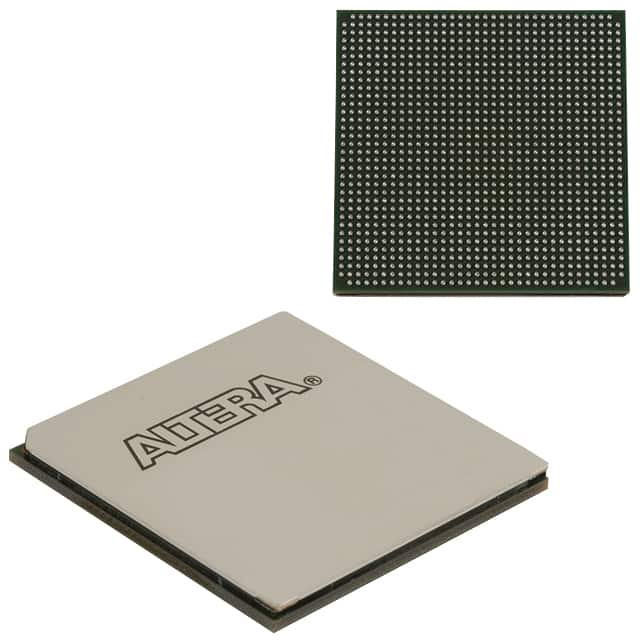Consulte las especificaciones para obtener detalles del producto.

5CGXFC9E6F35C7N
Product Overview
Category
The 5CGXFC9E6F35C7N belongs to the category of Field-Programmable Gate Arrays (FPGAs).
Use
FPGAs are integrated circuits that can be programmed and reprogrammed to perform various digital functions. The 5CGXFC9E6F35C7N is specifically designed for high-performance applications that require complex logic functions.
Characteristics
- High-performance FPGA with advanced features
- Large capacity for complex designs
- Low power consumption
- Flexible and reprogrammable
- Suitable for a wide range of applications
Package
The 5CGXFC9E6F35C7N comes in a compact package that ensures easy integration into electronic systems. It is available in a surface-mount package, which allows for efficient assembly on printed circuit boards (PCBs).
Essence
The essence of the 5CGXFC9E6F35C7N lies in its ability to provide a customizable and flexible solution for digital design requirements. Its programmable nature allows designers to implement complex logic functions without the need for custom-designed integrated circuits.
Packaging/Quantity
The 5CGXFC9E6F35C7N is typically packaged in reels or trays, depending on the manufacturer's specifications. The quantity per package may vary, but it is commonly available in quantities suitable for both prototyping and production purposes.
Specifications
- Logic Elements: 9,150
- Embedded Memory: 1,008 Kbits
- Maximum User I/Os: 622
- Maximum User I/O Pins: 622
- Operating Voltage: 1.2V
- Speed Grade: -7
- Package Type: FBGA
- Package Pins: 484
Detailed Pin Configuration
The 5CGXFC9E6F35C7N has a total of 484 pins, each serving a specific purpose in the FPGA's functionality. The pin configuration includes input/output pins, power supply pins, clock pins, and configuration pins. A detailed pinout diagram can be found in the product datasheet.
Functional Features
- High-speed performance: The 5CGXFC9E6F35C7N offers fast processing capabilities, making it suitable for applications that require real-time data processing.
- Flexible I/O options: With a large number of user I/O pins, the FPGA provides flexibility in connecting to external devices and peripherals.
- Embedded memory: The integrated memory blocks allow for efficient storage and retrieval of data within the FPGA itself.
- Configurability: The FPGA can be programmed using hardware description languages (HDLs) such as VHDL or Verilog, enabling designers to create custom logic functions.
Advantages and Disadvantages
Advantages
- Versatility: The 5CGXFC9E6F35C7N can be reprogrammed multiple times, allowing for design iterations and updates.
- Cost-effective: FPGAs eliminate the need for custom-designed integrated circuits, reducing development costs.
- Time-to-market: The programmable nature of FPGAs enables faster prototyping and shorter development cycles.
Disadvantages
- Complexity: Designing for FPGAs requires expertise in hardware description languages and digital logic design.
- Power consumption: FPGAs may consume more power compared to application-specific integrated circuits (ASICs) for certain applications.
- Limited performance optimization: While FPGAs offer high performance, they may not match the efficiency of dedicated ASICs for specific tasks.
Working Principles
The 5CGXFC9E6F35C7N operates based on the principles of configurable logic. It consists of an array of programmable logic blocks (PLBs) interconnected through configurable routing resources. The PLBs can be programmed to implement various logic functions, and the interconnections allow for data flow between different blocks.
The FPGA's configuration is stored in non-volatile memory, which is loaded during startup. Once configured, the FPGA operates as per the programmed logic, processing input signals and generating output signals based on the defined functionality.
Detailed Application Field Plans
The 5CGXFC9E6F35C7N finds applications in various fields that require high-performance digital processing. Some of the key application areas include:
- Communications: FPGAs are used in telecommunications equipment, such as routers and switches, to handle high-speed data processing and network traffic management.
- Industrial Automation: FPGAs play a crucial role in industrial automation systems, enabling real-time control and monitoring of processes.
- Aerospace and Defense: FPGAs are utilized in radar systems, avionics, and military-grade communication systems due to their ability to handle complex algorithms and high-speed data processing.
- Medical Devices: FPGAs are employed in
Enumere 10 preguntas y respuestas comunes relacionadas con la aplicación de 5CGXFC9E6F35C7N en soluciones técnicas
Sure! Here are 10 common questions and answers related to the application of 5CGXFC9E6F35C7N in technical solutions:
Q: What is the 5CGXFC9E6F35C7N? A: The 5CGXFC9E6F35C7N is a field-programmable gate array (FPGA) manufactured by Intel. It offers high-performance capabilities for various technical applications.
Q: What are the key features of the 5CGXFC9E6F35C7N? A: Some key features include a capacity of 9,158 logic elements, 35,840 adaptive look-up tables, 1,152 embedded memory blocks, and support for various I/O standards.
Q: What are some typical applications of the 5CGXFC9E6F35C7N? A: The 5CGXFC9E6F35C7N can be used in a wide range of applications such as telecommunications, industrial automation, automotive systems, medical devices, and high-performance computing.
Q: How can I program the 5CGXFC9E6F35C7N? A: You can program the 5CGXFC9E6F35C7N using Intel's Quartus Prime software, which provides a user-friendly interface for designing, simulating, and programming the FPGA.
Q: Can the 5CGXFC9E6F35C7N be reprogrammed after deployment? A: Yes, the 5CGXFC9E6F35C7N is a reprogrammable FPGA, allowing you to modify its functionality even after it has been deployed in a system.
Q: What are the power requirements for the 5CGXFC9E6F35C7N? A: The 5CGXFC9E6F35C7N typically operates at a voltage range of 1.2V to 3.3V, depending on the specific configuration and application requirements.
Q: Can I interface the 5CGXFC9E6F35C7N with other components or devices? A: Yes, the 5CGXFC9E6F35C7N supports various communication interfaces such as PCIe, Ethernet, USB, SPI, I2C, and UART, allowing seamless integration with other components or devices.
Q: Are there any development boards available for the 5CGXFC9E6F35C7N? A: Yes, Intel provides development kits like the Cyclone V GX Starter Kit, which includes the 5CGXFC9E6F35C7N FPGA along with necessary peripherals and software tools for prototyping and development.
Q: Can the 5CGXFC9E6F35C7N handle real-time processing requirements? A: Yes, the 5CGXFC9E6F35C7N offers high-performance capabilities, including dedicated digital signal processing (DSP) blocks, making it suitable for real-time processing applications.
Q: Where can I find additional resources and support for the 5CGXFC9E6F35C7N? A: You can refer to Intel's official website for datasheets, user guides, application notes, and community forums dedicated to the 5CGXFC9E6F35C7N. Additionally, Intel provides technical support for their FPGA products.

